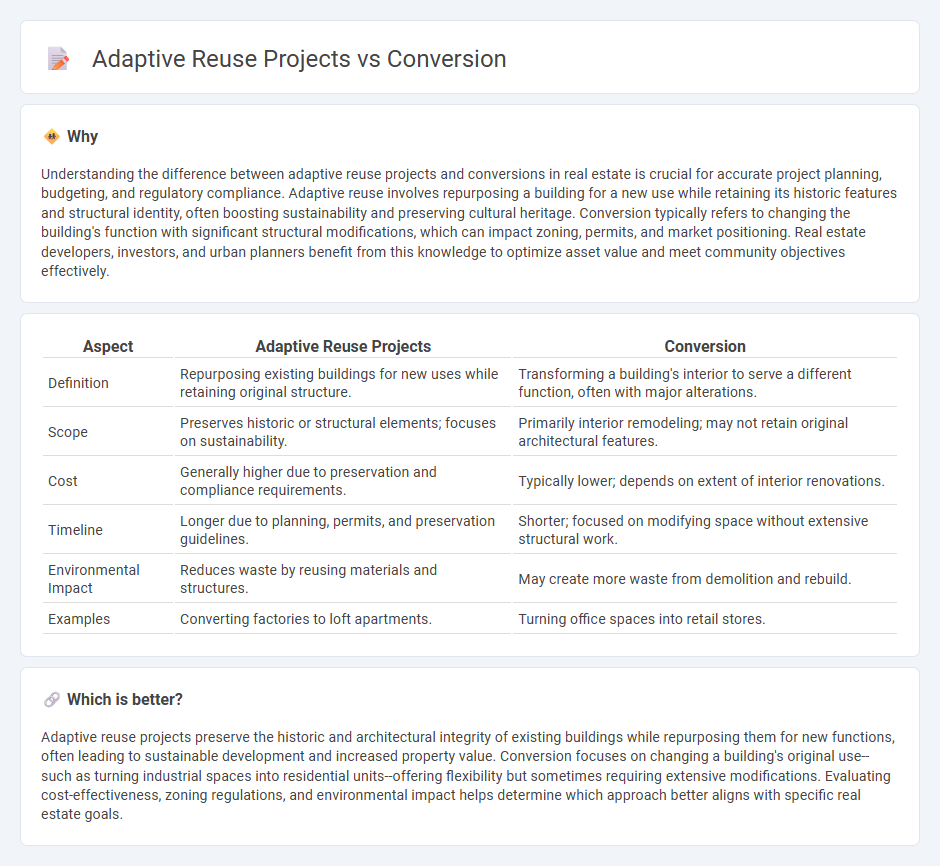
Adaptive reuse projects involve repurposing existing buildings for new functions while preserving their structural integrity and historical elements, maximizing sustainability and cost efficiency. Conversion specifically refers to changing a building's use, such as converting warehouses into residential lofts, often requiring structural modifications tailored to the new purpose. Explore the benefits and challenges of adaptive reuse versus conversion to discover the best strategies for your real estate development.
Why it is important
Understanding the difference between adaptive reuse projects and conversions in real estate is crucial for accurate project planning, budgeting, and regulatory compliance. Adaptive reuse involves repurposing a building for a new use while retaining its historic features and structural identity, often boosting sustainability and preserving cultural heritage. Conversion typically refers to changing the building's function with significant structural modifications, which can impact zoning, permits, and market positioning. Real estate developers, investors, and urban planners benefit from this knowledge to optimize asset value and meet community objectives effectively.
Comparison Table
| Aspect | Adaptive Reuse Projects | Conversion |
|---|---|---|
| Definition | Repurposing existing buildings for new uses while retaining original structure. | Transforming a building's interior to serve a different function, often with major alterations. |
| Scope | Preserves historic or structural elements; focuses on sustainability. | Primarily interior remodeling; may not retain original architectural features. |
| Cost | Generally higher due to preservation and compliance requirements. | Typically lower; depends on extent of interior renovations. |
| Timeline | Longer due to planning, permits, and preservation guidelines. | Shorter; focused on modifying space without extensive structural work. |
| Environmental Impact | Reduces waste by reusing materials and structures. | May create more waste from demolition and rebuild. |
| Examples | Converting factories to loft apartments. | Turning office spaces into retail stores. |
Which is better?
Adaptive reuse projects preserve the historic and architectural integrity of existing buildings while repurposing them for new functions, often leading to sustainable development and increased property value. Conversion focuses on changing a building's original use--such as turning industrial spaces into residential units--offering flexibility but sometimes requiring extensive modifications. Evaluating cost-effectiveness, zoning regulations, and environmental impact helps determine which approach better aligns with specific real estate goals.
Connection
Adaptive reuse projects transform existing buildings for new purposes, maximizing resource efficiency and preserving architectural heritage. Conversion is a subset of adaptive reuse, involving significant structural changes to repurpose a property's function, such as converting industrial warehouses into residential lofts. Both strategies contribute to sustainable real estate development by reducing the need for new construction and minimizing environmental impact.
Key Terms
Zoning Regulations
Conversion projects must comply with existing zoning regulations that often restrict changes in building use, whereas adaptive reuse projects may require zoning variances or special permits to accommodate new functions within historic structures. The primary challenge lies in aligning building code requirements with zoning restrictions related to occupancy, density, and parking, which differ significantly between conversion and adaptive reuse. Explore zoning regulations in depth to better navigate project approvals and maximize design flexibility.
Building Codes
Conversion projects modify existing buildings for entirely different uses, requiring compliance with current building codes for the new function, often triggering comprehensive upgrades to meet safety, accessibility, and energy efficiency standards. Adaptive reuse projects retain the building's original purpose while making significant renovations, allowing for more flexible application of building codes under preservation or historical guidelines. Explore detailed code requirements and distinctions for conversion and adaptive reuse projects to optimize compliance and project success.
Historic Preservation
Conversion projects involve changing the use of a historic building while maintaining its significant architectural features, preserving its cultural and historical value. Adaptive reuse focuses on repurposing historic structures for new functions, enhancing sustainability and community engagement by retaining the building's exterior and key elements. Explore how these approaches balance preservation goals with modern needs to safeguard heritage in evolving urban landscapes.
Source and External Links
Conversion - An intentional tort where a party takes possession of someone else's chattel property with the intent to deprive them of it.
Online Conversion - A resource that allows conversion between various units of measurement, including weights, measures, and more.
Xe Currency Converter - A tool for converting currencies using live exchange rates.
 dowidth.com
dowidth.com